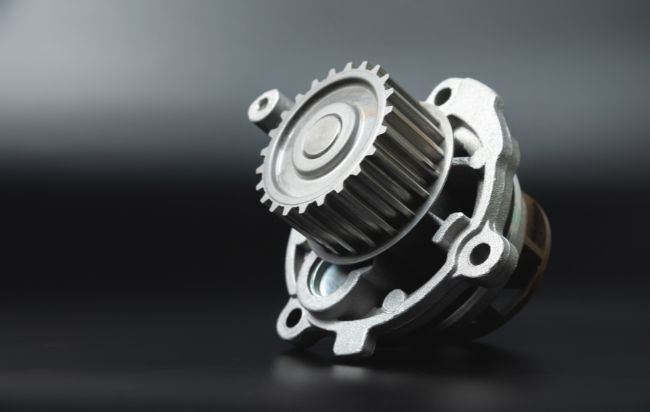
What Is a Water Pump?
The water pump allows coolant to circulate through and diverts heat away from the engine. This action allows the engine to remain cool and, by preventing it from overheating, guards against potential failure. As your engine experiences greater demand, the water pump will circulate more coolant to counteract the amount of heat being produced.
To do this, the pump includes an impeller with blades that forces the coolant to circulate. The part sits on a shaft with a seal and is powered by the crankshaft. As the engine starts to operate, coolant travels from the radiator to the water pump. The impeller helps the fluid move through the engine back to the radiator utilizing centrifugal force. The fluid cools once it returns to the radiator and will then circulate through the engine again.
Signs of Water Pump Failure
Typically, the water pump lasts 60,000 to 90,000 miles and the radiator hose has a lifespan of 100,000 miles. If the part experiences wear and tear, it can stop working, which causes the engine to overheat and experience a significant amount of damage.
- Leaking coolant forming a puddle on the ground
- Strange squeaking or squealing noises as you drive
- Coolant weeping from the water pump
- Green or orange residue in the coolant system’s overflow container
- Radiator steam, either as the car is moving or when it has stopped
- Inconsistent temperature gauge readings
Multiple factors are behind these issues:
- With time, high temperatures affect the water pump’s rubber and the material starts to form small cracks or holes.
- Debris traveling through the pump has an abrasive effect. This can occur if you mix tap water in with antifreeze.
- The coolant starts to deteriorate, taking on a rougher and more abrasive consistency.
- Another part responsible for cooling the engine, like the head gasket, thermostat or radiator stops working.
Water Pump Replacement Services
In terms of replacement, a belt-driven or chain-driven system powers the water pump. Sizes and locations can vary based on your car’s make and model. During the replacement of this part:
- Coolant in the system will be drained
- Certain parts like the timing belt may be removed to access the water pump
- A technician will inspect the pump and any related hoses and parts for damage
- The pump will be replaced if it’s showing damage, in addition to the radiator and thermostat cap and any related gaskets or seals
- New coolant will be added into the system and as the fluid circulates, a technician will examine it for any leaks
- Any parts previously taken out to access the water pump will be put back in.
If you’re noticing any of the above signs, have the technicians at DaSilva’s Auto Body inspect your car’s water pump and recommend any necessary repairs. To schedule an appointment, contact our Naugatuck shop today.

